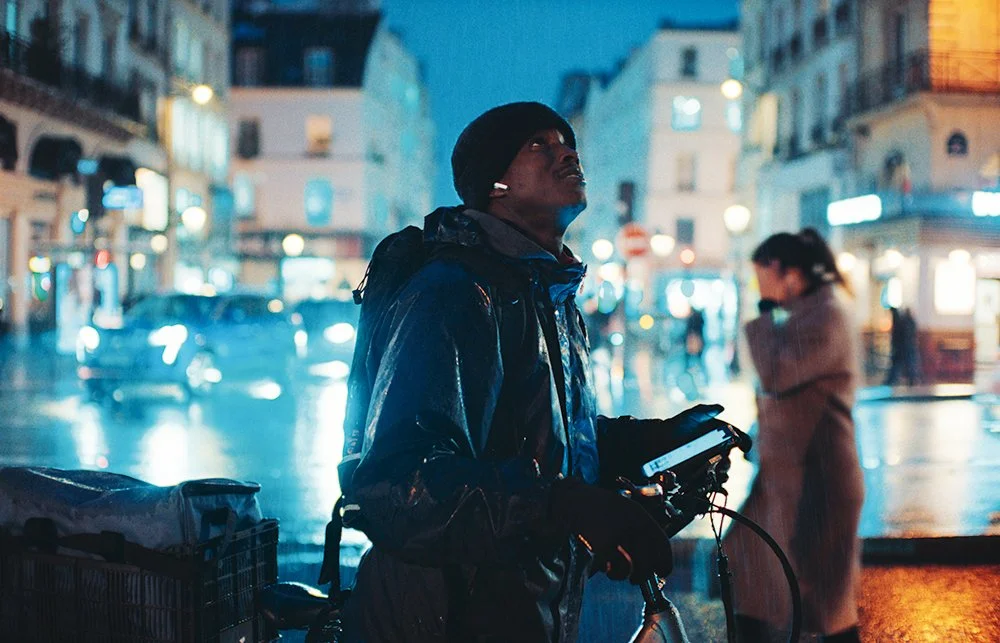Film Review - The Story of Souleymane
Images courtesy of Palace Films.
A visceral and unsettling study of Paris’ undocumented immigrants, Boris Lojkine’s 2024 French film, The Story of Souleymane, follows an Uber Eats delivery person and demonstrates the microcosmic reality of those unsupported by France’s immigration policy.
The narrative is refracted through protagonist Souleymane Sangaré’s perspective, following his journey over several days in preparation for his citizenship test and cycling through metropolitan Paris to satisfy food delivery orders. In occupying nearly every frame, Sangaré provides a perception of the economic and social standings of illegal immigrants, with the character’s journey consistently revealing limitations in attempts to gain citizenship, maintain a connection with his family in Guinea, find daily accommodation and support himself financially. Comparable to Eric Gravel’s Full Time (included in Alliance Français French Film Festival’s 2022 lineup), The Story of Souleymane achieves an element of realism; the sense of urgency and anxiety is integral to the plot and realised through the use of a handheld camera.
The French film was included in Alliance Français French Film Festival’s 2025 lineup and the Cannes Film Festival’s Un Certain Regard section in 2024, receiving the jury prize and the best actor award for Abou Sangaré. The debut actor, who immigrated from Guineu as a teenager and only obtained legal residency in France after working on the film, anchors the narrative which relies entirely on his character. Sangaré sustains a versatility of emotion as he oscillates between the film’s tragic, hopeful and stressful tones with incredible command of his facial and physical expressions. The pragmatic portrayal demands the audience’s attention, their entire viewing dependent on his performance.
The Story of Souleymane’s urban Parisian setting is cleverly utilised to reflect and heighten its protagonist’s stressful daily happenings, with Boris Lojkine’s use of handheld camera capturing situations kinetically, and creating a sense of realism and urgency. The overly populated streets exaggerate Sangaré’s raw, anxious performance with the background and soundtrack occupied with seemingly infinite traffic serving to further immerse the audience.
This same element of endless population is maintained when portraying scenes in a homeless shelter; the portrayal of immigrants and other homeless individuals is utilised here not to create a sense of anxiety, but rather to reveal the shockingly large sum of those that France’s government fails to support.
The Story of Souleymane’s exploration of the illegal immigrant experience ties into France’s Sans Papiers movement; a group of undocumented immigrants who hold protests and demonstrations to fight for their rights to legally work and live in France. Although the Sans Papiers is not explicitly mentioned in the film, the depiction of universal realities for immigrants (ID checks, financial support, achieving citizenship) reflects the movement’s goal to bring their common experiences to light.
The film’s ultimate downfall occurred only as a result of its technological limitations; a reflection not of the production quality but instead a revelation of the universal experience of immigrants. In passages where Souleymane is seen contacting family members still in his home country of Guinea through phone or video call, the tonal cohesion is ruptured and fails to maintain the audience’s immersion. While this choice does maintain the film’s realism element to a degree, the small screens and limited depiction of characters at what should’ve been an emotional climax for the film proved an interruption in the otherwise engaging narrative.
Boris Lojkine’s film, The Story of Souleymane, is ultimately exhilarating in its revelation of the hardships of illegal French immigrants, with its immersive nature making for an intense cinematic experience.
Follow Haidee on Instagram.
The Story of Souleymane is screening in cinemas now. For tickets and more info, click here.

